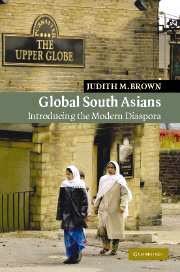Oct 16, 2025
Oct 16, 2025
by Shubha Singh
South Asia has been the region of major outward migration since the mid-1800s as people moved in search of work and better opportunities to countries around the world. The South Asian migration has been a diverse one with numerous strands leading to different countries around the world. During colonial times, people from the subcontinent went to work on plantations in other parts of the British empire. After independence, migrants from India, Pakistan and later Bangladesh traveled to the developed countries for work.
The Indian diaspora has been a subject of considerable interest and study in recent years, but there have been few attempts to study the South Asians settled abroad. Britain has a sizeable South Asian migrant community - over two million people of South Asian descent live in Britain, forming four percent of the population.
 A historian of modern South Asia, Prof Judith Brown (she is the author of 'Gandhi: Prisoner of Hope' and 'Nehru: A Political Life') has a deep knowledge of the diaspora in Britain. In 'Global South Asians - Introducing the Modern Diaspora', she has analyzed the South Asian migration and how the migrants adjusted to the life in the new countries and also made an impact in the host society. It provides a candid and interesting picture of a migrant community's trials and successes in making a new life for themselves - while many migrants have thrived in the new milieu, others still struggle to make a comfortable living.
A historian of modern South Asia, Prof Judith Brown (she is the author of 'Gandhi: Prisoner of Hope' and 'Nehru: A Political Life') has a deep knowledge of the diaspora in Britain. In 'Global South Asians - Introducing the Modern Diaspora', she has analyzed the South Asian migration and how the migrants adjusted to the life in the new countries and also made an impact in the host society. It provides a candid and interesting picture of a migrant community's trials and successes in making a new life for themselves - while many migrants have thrived in the new milieu, others still struggle to make a comfortable living.
The South Asians in Britain followed varying trajectories in their movement but they faced many similar situations when they reached Britain. Many went in the 1950s and 1960s to work in factories in the UK, others were "twice migrants" who moved from East Africa to Britain or migrated from Trinidad & Tobago and Guyana. While Indians took up jobs in the southeast and Midlands region and now have a presence in the suburbs of London, migrants from Pakistan went to west Midlands and the textile towns in the north. Bangladeshis are concentrated in inner London. The migrants settled in close groups but the upwardly mobile in the second generation South Asians have moved out of the ethnic conclaves.
Among the South Asians, the Indian migrants have prospered the most, particularly those who came from East Africa. Pakistanis live in the industrially declining areas and have a large majority of skilled, manual workers while the Bangladeshis are mainly semi-skilled and unskilled workers. South Asians regularly feature on the lists of millionaires, but there are high levels of unemployment among the Pakistanis and the Bangladeshis, almost double the national average even among the youth. The Pakistani and Bangladeshi migrants have congregated in the inner city areas where local industry has declined and state services are inadequate.
The marked differences in the economic experiences of the three main groups of South Asians, the author concludes, are due to the different skills they brought with them. The early Indian migrants were generally from a relatively better-off rural background than the Pakistani and the Bangladeshi migrants. Later day Indians were educated professionals and the East African migrants who came from urban areas with some trading and commercial skills.
Settling into a new environment has meant dealing with new stresses and tensions for all migrant South Asians, which has had an impact on their health. Diabetes is six times more common among South Asians than the rest of the population, and the incidence of heart disease is 46 percent higher for men and 51 percent higher for women of South Asian origin than for the general population. According to Brown, some of the health problems reflect genetic tendencies and or diet and attitudes to exercise.
The book explores the levels of accommodation achieved by the migrants, and the renegotiation that the next generation has to make in the process of assimilation in the host society. Though the major influences on this generation are from the environment in which they were born and grew up in, the ancestral homeland retains its place in the larger imagery of identity.
It is in their participation in political and civic life that South Asians have made a greater impact than other minorities in the country. South Asians have always been allowed to vote as citizens of Commonwealth countries. In the early days, most did not register as voters and even by the 1990s they were under-registered, 15 per cent were not registered. But South Asians have a larger turnout during elections, and though they do not vote as an ethnic bloc, the main political parties have recognized the significance of the South Asian voter. On their part, the South Asians have learnt the ways of British politics to focus attention to issues of South Asian concern.
(Shubha Singh can be contacted at shubyat@gmail.com)
31-Dec-2006
More by : Shubha Singh